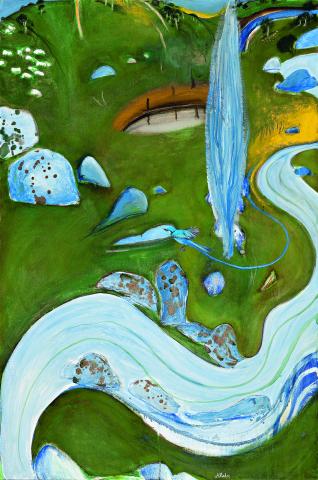BLUE AND GREEN PADDOCK, 1979
BRETT WHITELEY
oil, collage and mixed media on canvas board
90.5 x 60.5 cm
signed lower right: whiteley
Robin Gibson Gallery, Sydney
Private collection, Sydney
Tom Silver Fine Art, Sydney
Private collection, Melbourne, acquired from the above in 1994
Brett Whiteley: Portraits: Crucifixions: (a paddock at) Oberon, David Reid’s Gallery, Sydney, 26 April – 17 May 1980, cat. 31 (illus. exhibition catalogue, inside back cover)
‘Of all the subjects Whiteley painted in his career, landscape gave him the greatest sense of release…’1
Interestingly, when Blue and Green Paddock, 1979 was first unveiled in the artist’s highly acclaimed exhibition at Robin Gibson Galleries, Sydney in 1980, such lyrical pastorals were juxtaposed alongside Whiteley’s more tortured explorations of the Crucifixion theme featuring the ravaged body of his close friend and sculptor, Joel Elenberg, as the dying Christ. Diametrically opposed in their absence of suffering or anguish, these works represented a peaceful antidote to his darker, more painful musings – thus tangibly embodying the complex duality that so distinguishes his oeuvre. As Sandra McGrath elucidates, Whiteley frequently journeyed between poles: ‘…in truth he was living out one of his constant themes – good and evil, optimism and pessimism… all meshed into one overall psychological and pictorial design, one lifelong attempt to reconcile extremes, one eternal battle to identify the truth that E.M. Forster recognised as being accessible only by experiencing opposites.’2
Indeed, elaborating upon this dichotomy, Barry Pearce suggests that Nature offered the artist both inspiration and solace: ‘…if in many of his other themes Whiteley confronted the difficult questions of his psyche, landscape provided a means of escape, an unencumbered absorption into a painless floating world.’3 Accordingly, it is perhaps no surprise that upon his return to Australia in 1969 after a tumultuous decade abroad, Whiteley would embark upon an artistic pilgrimage to rediscover the beauty, vastness and variety of his homeland - first exploring the changing chromatic illusions and ‘optical ecstasy’ of Sydney’s Lavender Bay in sumptuous Matisse-like panoramas, before subsequently revisiting the landscape of his boyhood in the western New South Wales towns of Oberon, Kurrajong, Marulan, Carcoar and Bathurst. Indelibly embedded in his imagination, the gentle vales and hills of the countryside surrounding his school in Bathurst had been not only an important impetus for his precocious endeavours, but an endless source of inspiration over the intervening years. Equally influential were the compositions of Lloyd Rees which Whiteley had first admired at Macquarie Galleries one day after school – landscapes deeply poetic in their contemplation of soft curves and arabesques all rendered with impeccable tonality. As he later recalled in a letter to his artistic mentor, ‘…They contained nature and ideas, they contained naturalism but seemed also very invented, and the adventure of them was that they showed the decisions and revisions that had been made while they had been painted. I had never seen anything like that before… it set me on a path of discovery that I am still on today – namely that change of pace in a painting is where the poetry begins.’3
Closely related to the monumental Paddock – Early Morning, 1979 and The Paddock – Late Afternoon, 1979, Blue and Green Paddock is similarly a superb example from this series of paintings, drawings and etchings depicting the paddock near the house at Oberon where Whiteley lived over the winter of 1979. In his untiring efforts to capture this area in all its moods and myriad light effects, not only does Whiteley here betray affinities with the great Impressionists and plein air painters before him. More poignantly perhaps, he embraces a tendency which he described as ‘Chinese’, incorporating the repetition of certain motifs to symbolise states of mind – for example, the arabesque of the s-shaped meandering river echoing the flight path of birds, which in turn mirrored the artist’s relaxed journey through his own domain.
A celebration of the paddock in all its luxuriance and fecundity, indeed Blue and Green Paddock encapsulates Whiteley at his most lyrical with his signature sweeping calligraphic line, dominant palette of luminous blue, and unmistakable sense of freedom, optimism and indulgent sensuality. In stark contrast to the artist’s more gruelling, visually demanding canvases of previous years, there is no artifice here – no anthropomorphic forms or flamboyant burlesques, no hint of menace. Rather, the work is quite simply Whiteley’s eloquent tribute to the landscape of his childhood, imbued with a joyous love of Nature and its seasons. As Whiteley himself reflected upon such landscapes at the time, ‘…Sometimes I have to paint pictures that have an effortless naturalness, not artificial or synthetic, not manufactured – pictures that have no affectation through mental tricks, but graceful and according to nature.’4
1. Pearce, B., Brett Whiteley: Art and Life, Art Gallery of New South Wales, Sydney, 1995, p. 196
2. McGrath, S., Brett Whiteley, Bay Books, Victoria, 1979, p. 94
3. Pearce, op.cit.
4. Klepac, L., Lloyd Rees – Brett Whiteley: On the Road to Berry, Heide Museum of Modern Art, Melbourne, 1993, p. 7
5. McGrath, S., op. cit., p. 216
VERONICA ANGELATOS
